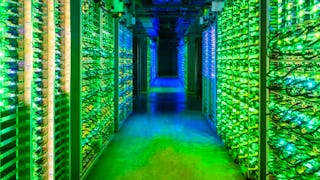In this course, you learn about data engineering on Google Cloud, the roles and responsibilities of data engineers, and how those map to offerings provided by Google Cloud. You also learn about ways to address data engineering challenges.

Enjoy unlimited growth with a year of Coursera Plus for $199 (regularly $399). Save now.

What you'll learn
Understand the role of a data engineer.
Identify data engineering tasks and core components used on Google Cloud.
Understand how to create and deploy data pipelines of varying patterns on Google Cloud.
Identify and utilize various automation techniques on Google Cloud.
Skills you'll gain
Details to know

Add to your LinkedIn profile
6 assignments
See how employees at top companies are mastering in-demand skills

There are 8 modules in this course
This section welcomes you to the Introduction to Data Engineering on Google Cloud course, and provides an overview of the course structure and goals.
What's included
1 video
This module provides an introduction to the role of a data engineer. It covers key concepts such as data sources and sinks, data formats, storage options on Google Cloud, metadata management, and the use of Analytics Hub for data sharing within and outside an organization.
What's included
8 videos1 assignment1 app item1 plugin
This module provides an overview of data replication and migration on Google Cloud. It covers the basic architecture, the 'gcloud' command-line tool, Storage Transfer Service, Transfer Appliance, and Datastream, along with their functionalities and use cases.
What's included
6 videos1 assignment1 app item
This module focuses on data extraction and loading processes on Google Cloud, particularly with BigQuery. It covers the basic extraction and loading architecture, the bq command-line tool, BigQuery Data Transfer Service, and BigLake as an alternative to traditional extract-load patterns.
What's included
6 videos1 assignment1 app item
This module provides an overview of ELT (extract, load, transform) processes on Google Cloud. It covers the basic ELT architecture, a common ELT pipeline example, BigQuery's capabilities for scripting and scheduling SQL, and the functionality and use cases of Dataform.
What's included
5 videos1 assignment1 app item
This module provides an overview of ETL (extract, transform, load) processes on Google Cloud. It covers the basic ETL architecture, GUI tools, batch and streaming data processing options (Dataproc, Dataproc Serverless), and the role of Bigtable in data pipelines.
What's included
8 videos1 assignment2 app items
This module focuses on automation patterns and options for pipelines on Google Cloud. It covers various tools and services like Cloud Scheduler, Workflows, Cloud Composer, Cloud Run functions, and Eventarc, along with their functionalities and use cases for automation.
What's included
7 videos1 assignment1 app item
In this final section, we review what was presented in this course and discuss the next steps to continue your cloud learning journey.
What's included
1 video1 reading
Instructor

Offered by
Explore more from Cloud Computing
 Status: Free Trial
Status: Free TrialDeepLearning.AI
 Status: Free Trial
Status: Free TrialDuke University
 Status: Free Trial
Status: Free Trial Status: Free Trial
Status: Free Trial
Why people choose Coursera for their career





Open new doors with Coursera Plus
Unlimited access to 10,000+ world-class courses, hands-on projects, and job-ready certificate programs - all included in your subscription
Advance your career with an online degree
Earn a degree from world-class universities - 100% online
Join over 3,400 global companies that choose Coursera for Business
Upskill your employees to excel in the digital economy
Frequently asked questions
Yes, you can preview the first video and view the syllabus before you enroll. You must purchase the course to access content not included in the preview.
If you decide to enroll in the course before the session start date, you will have access to all of the lecture videos and readings for the course. You’ll be able to submit assignments once the session starts.
Once you enroll and your session begins, you will have access to all videos and other resources, including reading items and the course discussion forum. You’ll be able to view and submit practice assessments, and complete required graded assignments to earn a grade and a Course Certificate.
More questions
Financial aid available,

